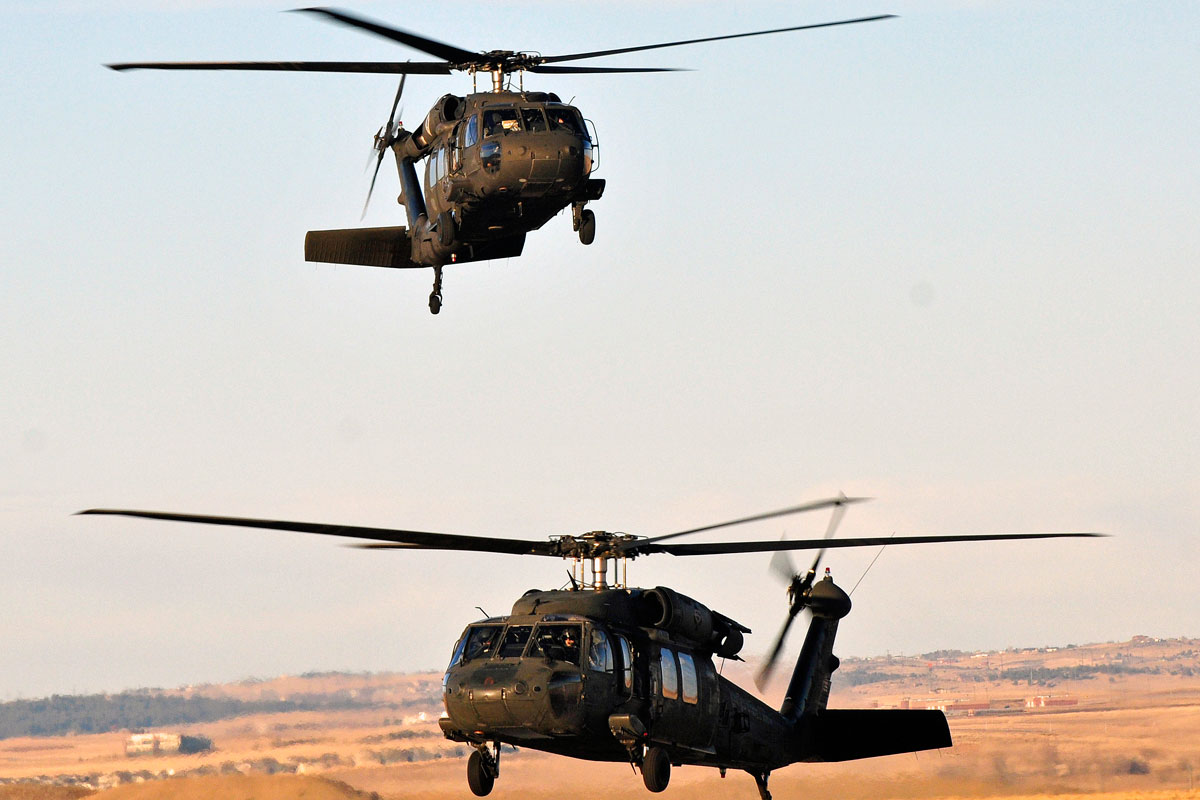Safety First: Critical Steps in UH 60 Helicopter Maintenance
Safety First: Critical Steps in UH 60 Helicopter Maintenance
Blog Article
Recognizing the Mechanics and Design Behind Uh 60 Helicopters
The UH-60 helicopter, generally recognized as the Black Hawk, stands as a peak of modern-day rotorcraft modern technology, embodying a mix of durable engineering and complex technicians. As we peel back the layers of the UH-60's layout, a world of complex systems and meticulous design comes to light.
History of UH-60 Helicopters
The history of UH-60 helicopters traces back to the late 1970s when the United States Army looked for a innovative and versatile energy helicopter to replace its aging fleet. In reaction to this need, the Sikorsky Aircraft Company created the UH-60 Black Hawk helicopter. Introduced in 1979, the UH-60 quickly came to be a staple in military procedures due to its excellent capabilities.
The UH-60 was designed to master a variety of goals, consisting of army transport, clinical evacuation, digital war, and unique procedures. Its capability to adjust to various roles made it a valuable property to the U.S. uh 60. Military and other army forces around the world
For many years, the UH-60 system has actually gone through a number of upgrades and variants to enhance its performance and equal advancing objective demands. These helicopters have seen considerable service in problems such as the Gulf Battle, Afghanistan, and Iraq, showcasing their reliability and versatility in varied functional settings. The UH-60's rich history is a testament to its enduring legacy as a top utility helicopter.

Engine and Power Solutions
Using sophisticated propulsion innovation, UH-60 helicopters are equipped with innovative engine and power systems to guarantee optimum efficiency and dependability in a series of operational scenarios. The UH-60, generally recognized as the Black Hawk, is powered by 2 General Electric T700-GE-701D engines, each efficient in providing up to 1,940 shaft horsepower. These turboshaft engines offer the essential drive for the helicopter to execute its goals successfully, consisting of troop transportation, medical evacuation, and battle assistance.

Rotor System and Aerodynamics
How do the blades system and aerodynamics of UH-60 helicopters contribute to their operational performance and flight abilities? The rotor system of the UH-60 helicopter plays a vital role in supplying lift and propulsion. The UH-60 includes a four-bladed, completely expressed rotor system that allows for high ability to move and stability throughout trip. This layout allows the helicopter to execute a large range of goals, from transportation and medical discharge to battle operations.
Aerodynamics also play a key duty in the efficiency of UH-60 helicopters. The streamlined body and blades blade layout reduce drag, permitting the helicopter to attain greater rates and much better gas discover this effectiveness. The wind resistant design of the UH-60 also contributes to its ability to run in varied environmental problems, consisting of warm temperature levels and high elevations.
Avionics and Trip Control Equipment

In its complex coordination with the blades system and aerodynamics of UH-60 helicopters, the avionics and trip control systems develop an important network of modern technologies forming the airplane's operational capabilities. Avionics incorporate the digital systems utilized for communication, navigation, and monitoring different airplane functions. In the UH-60, these systems include digital displays, communication radios, GPS navigating, climate radar, and autopilot systems. These avionics systems give critical information to the pilots, improving situational recognition and making sure efficient and secure operation of the helicopter.
The flight control systems of the UH-60 are accountable for converting the pilot's inputs into the proper changes to the blades system, ensuring steady flight and ability to move. These systems include hydraulic actuators, servos, and computer systems that collaborate to manage the major and tail rotors, as well as other flight control surface areas. explanation By exactly handling the helicopter's flight dynamics, these systems allow pilots to execute a vast array of missions, from transport and search-and-rescue to combat operations, with accuracy and self-confidence.
Function and Applications in Aviation
Avionics systems in UH-60 helicopters incorporate a variety of digital systems that aid in navigating, communication, monitoring, and managing numerous aircraft features. These systems consist of electronic screens, autopilot systems, communication radios, General practitioner navigation devices, and weather condition radar. Additionally, these systems incorporate security functions such as autopilot modes, surface understanding cautioning systems, and stability augmentation systems to boost the overall safety and operational capacities of the UH-60 helicopters in numerous goals, including army transportation, clinical discharge, search and rescue, and airborne firefighting.
Final Thought
Finally, the UH-60 helicopter is a versatile airplane with an abundant background and progressed design. Its engine and power systems, blades system, aerodynamics, avionics, and flight control systems all collaborate to make it a reputable and reliable equipment. The UH-60's duty and applications in air travel are huge, varying from armed forces procedures to search and rescue missions. Its continued growth and use show its significance in the area of air travel (uh 60).
In its complex sychronisation with the rotor system and the rules of aerodynamics of UH-60 helicopters, the avionics and flight control systems create an important network of modern technologies forming the airplane's functional capabilities.The trip control systems of the UH-60 are liable for converting the pilot's inputs right into the ideal adjustments to the rotor system, ensuring stable trip and ability to move. Avionics systems in UH-60 helicopters include click here now an array of electronic systems that help in navigation, communication, tracking, and controlling numerous aircraft functions. Furthermore, these systems include safety and security functions such as autopilot settings, terrain awareness alerting systems, and stability enhancement systems to improve the overall safety and functional capabilities of the UH-60 helicopters in numerous goals, including army transport, medical evacuation, search and rescue, and aerial firefighting.
Its engine and power systems, blades system, the rules of aerodynamics, avionics, and trip control systems all work together to make it a reliable and efficient machine.
Report this page